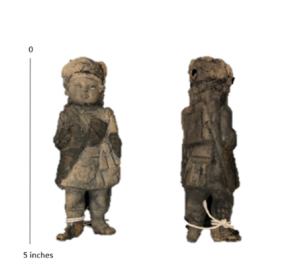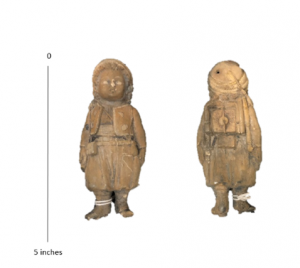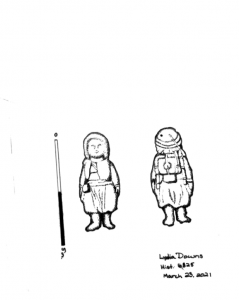The rattles that I examined were originally made of rubber but their time under water has made them hard and now they have a consistency that is much more like ceramics when held. Amazingly, each one still had the rattle inside which could be heard rolling around when the rattle was tipped or turned. The first one that I looked at was a 5 inches tall figurine of a soldier in Scottish regalia, #081, dating back to 1876-1878. The details in the figure’s cloths and features are very clear even after all this time. Sadly, it is severely discolored and is now only hues of grays and browns.

Figure 1: Rattle, #081, both front and back view (Photos courtesy of Lydia Downs)
The second rattle, #080, was another figurine shaped rattle, this one having the appearance of a girl wearing traditional clothing. Much like the first, this rattle also measures 5 inches tall and dates to 1876-1878. The back of the figurine appears to be pressed in as if it had been bearing some sort of weight. In its hardened state, after spending over one hundred years in the marine environment, it is unlikely that it will return to its original shape. Additionally, its coloration is similar to that of the other figurine rattle. A drawing of this rattle can be seen in Figure 5.

Figure 2: Rattle, #080, both front and back view (Photos courtesy of Lydia Downs).
The third rattle I looked at, #077, was a different kind from the first two. It had a ball at one end with a handle that led down to a ring on the other end. There were letters carved into the ball indicating that it was manufactured by the New York Rubber Company. Like the figurines it also dates back to 1876-1878. Years in the water had made the coloration similar to that of the other rattles and the carvings were also equally distinct. This rattle had a face on either side of the ball, one crying and one laughing, which made it much more creepy than cute. Unfortunately, its time in the ocean had made it extremely fragile and the handle had broken splitting the 7-inch rattle into 2 pieces.

Figure 3: Rattle, #077, both front and back view (Photos courtesy of Lydia Downs).
The fourth and final rattle that I examined, #078, was another 7-inch long ball with a handle leading down to a ring on the opposite end. The ball of this rattle was designed with pictures of children playing games, and angles ornamenting the base of the ball. It was in better condition than the other handled rattle in that it remains intact rather than broken into two pieces. It too, have the letter printed on it indicating that the New York Rubber Company was the manufacturer, and it dates back to 1876-1878. The features of the rattle are still very distinct but again, like the others, the coloring consists of hues of greys and browns.

Figure 4: Rattle, #078, both front and back view (Photos courtesy of Lydia Downs).
Current Status of the Rattles:
The rattles are currently part of a larger collection of artifacts from the City of Houston that reside at the North Carolina Maritime Museum in Beaufort, North Carolina. The museum contains a broad array of artifacts and exhibits covering many aspects of maritime life and culture. Topics such as fishing, boat building through the ages, marine life, and pirating are just a few of the subjects of interest within the museum.
As part of their public outreach, there is a viewing window from the exhibit area into the conservation lab so that patrons can see the processes that go into preserving different types of artifacts. The museum is quite small and they have hopes of expanding but until that time most of their artifacts, including the four rattles that I examined, remain in storage.
Appendix
Drawing of the rattle displayed in figure 2.

Figure 5: Drawing of the rattle in the form of a girl in traditional dress. (Drawing courtesy of Lydia Downs).
References:
“NC Maritime Museum : BEAUFORT.”
2021 NC Maritime Museum BEAUFORT, ncmaritimemuseumbeaufort.com/.
Wreck of the City of Houston
2004 www.nc-wreckdiving.com/WRECKS/HOUSTON/HOUSTON.HTML.
